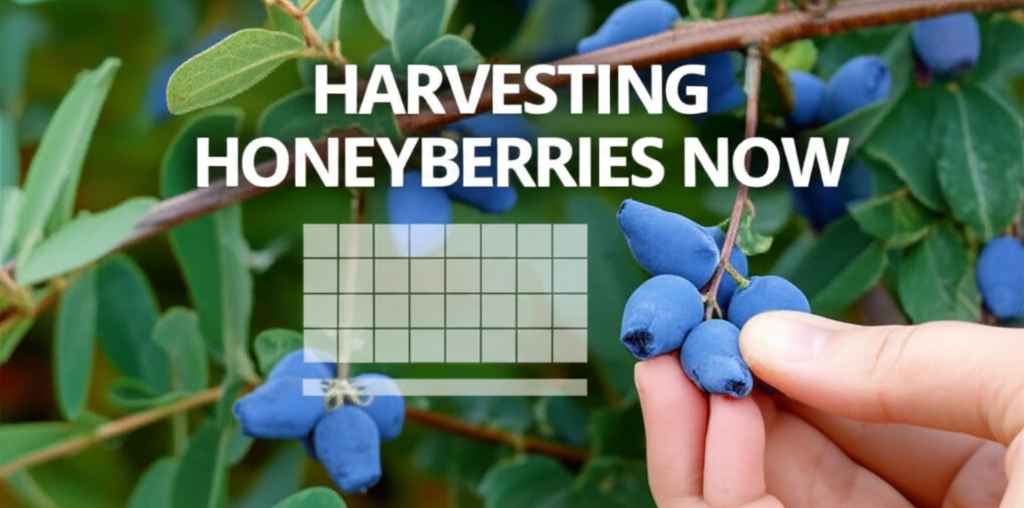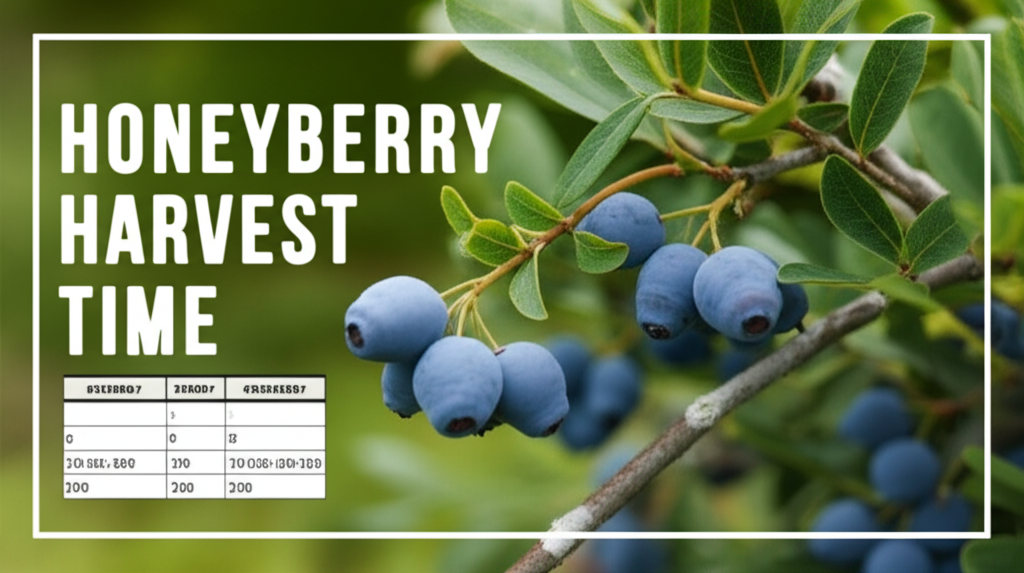Understanding the Honeyberry Shrub
What are Honeyberries?
Honeyberries, also known by their botanical name Lonicera caerulea, are fascinating and increasingly popular shrubs prized for their nutritious and delicious fruit. Often referred to as “haskap” berries in some regions, these plants are native to colder climates in the Northern Hemisphere, including parts of Siberia, Japan, and Canada. What sets honeyberries apart is their remarkably early ripening period, often being the first fruit to be harvested in the late spring or early summer. This makes them a highly anticipated crop for home gardeners and commercial growers alike.
The berries themselves are elongated, oval-shaped, and typically a deep blue to purplish color, resembling a large blueberry or an elongated blueberry in appearance. Their flavor is a unique and complex blend, often described as tart and sweet with notes of blueberry, raspberry, and sometimes even a hint of plum or grape. This distinctive taste profile makes them versatile for fresh consumption, jams, jellies, juices, pies, and other culinary creations.
Nutritional Powerhouse
Beyond their delightful taste, honeyberries are celebrated for their exceptional nutritional value. They are packed with antioxidants, particularly anthocyanins, which contribute to their vibrant blue hue and are linked to numerous health benefits, including improved heart health, reduced inflammation, and enhanced cognitive function. They are also a good source of Vitamin C, Vitamin A, dietary fiber, and potassium, making them a true superfood.
Growing Conditions for Optimal Harvest
To ensure a successful and bountiful honeyberry harvest, understanding their preferred growing conditions is crucial. Honeyberry shrubs are remarkably hardy, tolerating temperatures well below freezing. They thrive in full sun to partial shade, with at least six hours of direct sunlight daily being ideal for maximum fruit production.
Soil-wise, they prefer well-drained, slightly acidic to neutral soil (pH 5.5-7.0). While they can tolerate a range of soil types, amending heavy clay soils with organic matter like compost or well-rotted manure will significantly improve drainage and aeration, promoting healthier root development and ultimately, a better harvest. Consistent moisture is also important, especially during the fruit development stage, though they are relatively drought-tolerant once established.
Pollination is Key
A critical factor for honeyberry fruit production is cross-pollination. Honeyberry plants are not self-pollinating, meaning they require at least two different varieties of honeyberry bushes planted in close proximity (within 50 feet) to produce fruit. When selecting varieties, it’s important to ensure they have overlapping bloom times. Fortunately, most commercially available honeyberry varieties are bred to be compatible with each other. Planting multiple varieties not only ensures pollination but can also extend the harvest period slightly.
The Honeyberry Harvesting Calendar

When Do Honeyberries Ripen?
The exact ripening time for honeyberries can vary significantly based on several factors, including geographic location, climate, specific cultivar, and local weather patterns during the growing season. However, honeyberries are renowned for their early maturity.
In most northern temperate regions, the honeyberry season typically begins in late May or early June and can extend through July. This makes them one of the very first fruits to become available to harvest in many areas. Southern regions or areas with warmer springs might see an earlier start, potentially in mid-May. Conversely, cooler regions or those experiencing late frosts might see a slightly later commencement.
Factors Influencing Ripening Time
- Climate and Zone: The most significant factor. Colder climates will generally have a later start and end to the season compared to warmer climates.
- Cultivar: Different honeyberry varieties have been developed with slightly different ripening windows. Some might be considered “early,” “mid-season,” or “late” within the broader honeyberry season.
- Sunlight Exposure: Bushes receiving ample sunlight will generally ripen their fruit faster than those in shadier spots.
- Water Availability: Consistent moisture, especially during fruit development, can contribute to earlier and more uniform ripening.
- Pollination Success: While not directly impacting ripening time, successful pollination is essential for fruit set, which then leads to ripening.
Signs of Ripeness
Identifying when honeyberries are ready for harvest is relatively straightforward. The most obvious indicator is the color. Honeyberries will transform from a light green to a deep blue or purplish hue. However, color alone isn’t always the definitive sign, as some varieties may have lighter blue tones even when ripe.
The texture of the berry is another key indicator. Ripe honeyberries will feel slightly soft and yielding when gently squeezed, similar to a ripe blueberry. They should also detach easily from the stem with a gentle tug. If the berry resists, it’s likely not fully ripe yet.
Finally, taste is the ultimate test. A ripe honeyberry will have a balanced sweet and tart flavor. Unripe berries will be predominantly sour and astringent. It’s always a good idea to taste a few berries from different parts of the bush to gauge ripeness.
Harvesting Techniques
Harvesting honeyberries is a simple and enjoyable process. Due to their delicate nature, it’s best to harvest them by hand.
- Gentle Plucking: Carefully pluck the berries individually from the bush. They should come away easily from the stem when ripe.
- Container: Use shallow containers or trays to collect the berries, as they can bruise easily if piled too high. This also helps in inspecting the berries for ripeness and any potential damage.
- Frequency: Honeyberries don’t typically ripen all at once. It’s advisable to check the bushes every few days and harvest only the ripe berries, allowing the others to mature. This staggered harvesting can extend your berry-picking enjoyment over several weeks.
- Washing: It’s generally recommended to wash honeyberries just before you plan to use them, rather than washing them immediately after picking. This helps to preserve their freshness and prevent mold during storage.
Honeyberry Harvesting Calendar by Region (General Guide)
While specific dates are variable, here is a general guideline for when you can expect to start harvesting honeyberries in different regions. This assumes standard growing conditions and typical weather patterns.
North America
- Northern United States (e.g., Minnesota, Wisconsin, Michigan, New England): Late May to Mid-July
- Canada (e.g., Ontario, Quebec, Manitoba): Late May to Mid-July
- Pacific Northwest (e.g., Washington, Oregon): Early June to Mid-July
- Northern Plains (e.g., North Dakota, South Dakota): Early June to Mid-July
Europe
- Scandinavia: June to July
- United Kingdom: Late June to August
- Central Europe: June to July
Asia
- Siberia: Late June to August
- Japan (Hokkaido): June to July
Note: This is a generalized calendar. Local microclimates, specific cultivars, and annual weather variations can cause deviations. Always monitor your plants closely.
Key Facts and Comparison
Honeyberries offer a distinct advantage with their early ripening season, positioning them as a valuable crop for extending the berry season. Here’s a comparison with other popular berries:
| Berry Type | Typical Ripening Window | Flavor Profile | Primary Growing Regions |
|---|---|---|---|
| Honeyberry (Lonicera caerulea) | Late May – July | Sweet-tart, notes of blueberry, raspberry, plum | Cold climates (Northern Hemisphere) |
| Strawberry (Fragaria × ananassa) | May – June (early varieties); June – July (main season) | Sweet, slightly tart, aromatic | Wide range, temperate climates |
| Blueberry (Vaccinium spp.) | June – August (depending on variety and region) | Sweet, mild tartness | Acidic soil, temperate climates |
| Raspberry (Rubus idaeus) | June – July (summer-bearing); August – October (fall-bearing) | Sweet, tart, distinct aroma | Temperate climates |
| Blackberry (Rubus spp.) | July – August | Sweet, tart, sometimes seedy | Temperate climates |
Pros and Cons of Honeyberry Harvesting
Harvesting honeyberries, like any fruit, comes with its own set of advantages and considerations. Understanding these can help you maximize your success and enjoyment.
| Aspect | Details |
|---|---|
| Pros |
|
| Cons |
|
Maximizing Your Honeyberry Harvest
Post-Harvest Care for Your Bushes
After the last berries have been picked, it’s important to provide your honeyberry bushes with appropriate care to ensure their health and productivity for the following seasons.
- Watering: Continue to water your plants, especially during dry spells, to help them recover from the fruit-bearing season and prepare for dormancy.
- Weeding: Keep the area around the base of the bushes free from weeds, which compete for water and nutrients.
- Fertilizing: A light application of balanced fertilizer in the fall can help replenish nutrients, but avoid excessive nitrogen, which can lead to weak growth.
- Pruning: The best time to prune honeyberries is typically in late winter or early spring, before new growth begins. Remove any dead, damaged, or crossing branches. Pruning also helps to improve air circulation and light penetration into the center of the bush, promoting healthier fruiting wood for the next year. Aim to maintain an open structure.
- Mulching: Applying a layer of organic mulch around the base of the bushes can help retain soil moisture, suppress weeds, and regulate soil temperature.
Storage and Preservation
Honeyberries have a limited shelf life when stored fresh. For optimal quality, it’s best to consume them within a few days of harvesting. However, their unique flavor profile makes them excellent candidates for longer-term preservation.
- Refrigeration: Store unwashed berries in a single layer in a shallow container in the refrigerator. They should last for about 5-7 days.
- Freezing: Honeyberries freeze exceptionally well. Spread the berries in a single layer on a baking sheet and freeze until solid. Once frozen, transfer them to airtight freezer bags or containers. Frozen honeyberries are ideal for smoothies, baked goods, and sauces and can last for 6-12 months.
- Drying: Honeyberries can also be dried, either in a dehydrator or a low oven, to create a chewy, concentrated snack.
- Jams and Jellies: Their natural pectin content and tart-sweet flavor make them perfect for creating delicious homemade jams and jellies.
- Juices and Purees: Extracting juice or making purees is another excellent way to preserve the flavor and nutrients of honeyberries for later use.
Troubleshooting Common Harvesting Issues
While honeyberries are generally hardy, a few issues can arise that might affect your harvest.
- No Fruit or Poor Fruit Set: This is almost always due to insufficient cross-pollination. Ensure you have at least two different honeyberry varieties planted close together with overlapping bloom times.
- Birds and Wildlife: Birds are attracted to the sweet berries. Netting the bushes as the fruit begins to ripen can be an effective deterrent. Other wildlife may also be an issue depending on your location.
- Inconsistent Ripening: This can be due to uneven sunlight exposure or varying water availability across the bush. Pruning can help improve light penetration.
- Berries Falling Off Prematurely: This can sometimes indicate a lack of water or heat stress, although some natural drop is normal as berries ripen.
Conclusion
The honeyberry shrub offers a unique and rewarding experience for gardeners and fruit enthusiasts. Their exceptionally early ripening season, coupled with their impressive nutritional profile and delightful flavor, makes them a valuable addition to any edible landscape. By understanding the honeyberry harvesting calendar, paying attention to the signs of ripeness, and employing proper harvesting and post-harvest care techniques, you can maximize your yield and fully enjoy the bounty of these remarkable berries from late spring through the summer months. Happy harvesting!


